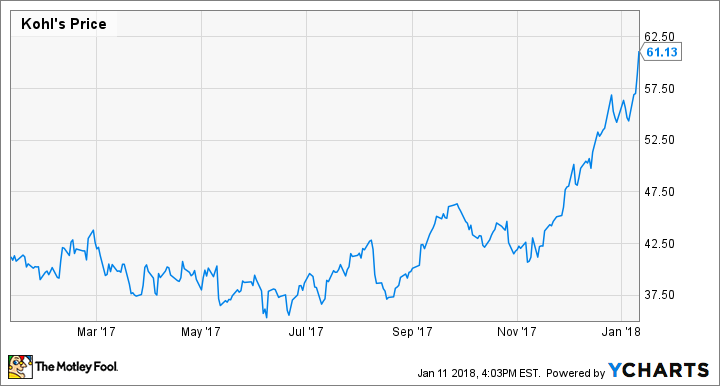Last Monday, department-store giant Kohl's (KSS 2.64%) reported stellar sales results for the November-December holiday period. Comparable (comp) sales surged 6.9% year over year compared to a 1% decline in the first nine months of the fiscal year.
Based on this strong performance, Kohl's boosted its full-year earnings per share (EPS) guidance range significantly. The company now expects to post adjusted EPS of $3.98-$4.08, up from its previous forecast of $3.60-$3.80. As a result, Kohl's stock has soared to a new 52-week high.
Kohl's Stock Performance, data by YCharts.
While Kohl's stock has risen by more than 70% since bottoming out in June, it could still have plenty of additional upside. Furthermore, Kohl's big acceleration in sales suggests that off-price leaders Ross Stores (ROST 0.57%) and TJX Companies (TJX +0.36%) could be primed for strong sales and earnings growth -- driving their share prices higher, as well.
Kohl's is just getting started
During fiscal 2016, Kohl's posted EPS of $3.76. Its initial guidance for 2017 implied that EPS would be flat, or down, in the current fiscal year. By contrast, based on the midpoint of its updated guidance range, Kohl's now expects 7% EPS growth in fiscal 2017.
Kohl's stock trades for about 15 times its increased 2017 EPS forecast. That might seem too generous, given the secular headwinds facing department stores. However, Kohl's recent sales momentum shows that it's well-positioned to capitalize on an uptick in retail sales growth.
Very few of its stores are located in traditional malls. This gives Kohl's a convenience factor that's helping it gain share from department-store rivals and profit from store closings across the retail landscape.
Management isn't resting on its laurels. Kohl's is working on a variety of initiatives to drive more traffic to its stores. It's also looking to sell or lease out space in lower-volume stores, both to bring in extra cash and to drive incremental traffic to those locations.

Kohl's plans to lease out excess space in some of its stores. Image source: Kohl's.
Continued comp-sales growth would allow Kohl's to start rebuilding its profit margin. In fiscal 2016, Kohl's reported an adjusted operating margin of 7.3%, down from 8.9% in fiscal 2014 and 9.8% in fiscal 2012. (The updated fiscal 2017 guidance implies that Kohl's full-year operating margin would be roughly flat year over year.)
If a return to comp-sales growth were to boost Kohl's operating margin to 8.5% in 2018 -- well below the levels achieved a few years ago -- it would increase pre-tax income by 20%-25%. The recent reduction in the corporate tax rate will boost after-tax income by an additional 22% or so. Share buybacks would accelerate EPS growth even further.
The net result is that Kohl's EPS could very easily sail past $6 in the coming year. Free cash flow would be even higher due to tax benefits, disciplined capital spending, and Kohl's ongoing inventory reductions. As a result, Kohl's stock could have plenty of room to run.
Ross Stores has more upside, as well
If Kohl's is benefiting from strong consumer spending and favorable off-mall store locations, chances are that Ross Stores is in even better shape. While the rest of fashion retail was down in the dumps during the first three quarters of fiscal 2017, Ross Stores posted 4% comparable-store sales growth.

Ross Stores has posted stellar comp sales growth in the past year. Image source: Ross Stores.
Ross Stores' guidance calls for a 2%-3% comp-sales increase in the fourth quarter. However, the company routinely blows past its forecasts. Considering that it posted a 4% comp-sales gain in the third quarter while facing its toughest year-over-year comparison -- in a bad quarter for fashion retail, no less -- it wouldn't be surprising if Ross Stores achieves high-single-digit comp-sales growth this quarter.
Like Kohl's, Ross Stores is poised to get a roughly 22% earnings boost from tax reform. That would increase its baseline EPS for 2017 to around $4. If consumer spending remains strong in 2018, another 12%-15% EPS increase -- which has been routine in recent years -- should be achievable. That would push EPS past $4.50.
Ross Stores' stock now trades for more than $80, so it isn't exactly a bargain. But management sees room to expand the store footprint by more than 50% in the coming years, providing ample growth opportunities to drive the stock even higher.
Expect a turnaround at TJX
Until 2017, TJX was performing just as well as its smaller rival, Ross Stores. However, in the first three quarters of the current fiscal year, TJX's comp sales rose just 1%. Unfavorable weather and some merchandise missteps prevented a stronger performance.
On the bright side, TJX is already addressing these issues. Furthermore, its subpar sales results over the past year have set up very easy comparisons, which could enable the company to post mid-high single-digit comp-sales growth in the coming year. Like Kohl's and Ross Stores, TJX will see a big EPS benefit from tax reform going forward, and the stock is significantly cheaper than that of Ross Stores.
Indeed, TJX's EPS should comfortably surpass $5 in the upcoming year, giving the stock a modest valuation of 15 times forward earnings. As long as the company delivers steady sales and earnings growth for the next several quarters, TJX stock could race higher. If Kohl's holiday-season results are any indication, the current retail-sales climate makes this very achievable.







